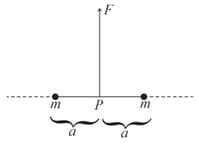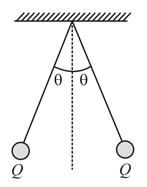Two spheres A and B of exactly same mass are given equal positive and negative charges respectively. Their masses after charging
Important Questions on Electrostatics
Mention one difference between mass and charge.
As shown in the figure, two particles, each of mass tied at the ends of a light string of length are kept on a frictionless horizontal surface. When the mid point of the string is pulled vertically upwards with a small but constant force the particles move towards each other on the surface. Magnitude of acceleration of each particle, when the separation between them becomes is

Two pith balls each with mass are suspended from insulating threads. When the pith balls are given equal positive charge , they hang in equilibrium as shown. We now increase the charge on the left pith ball from to while leaving its mass essentially unchanged. Which of the following diagrams best represents the new equilibrium configuration?


